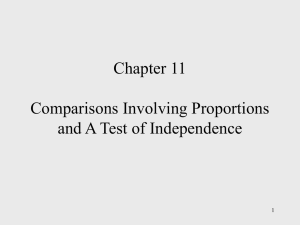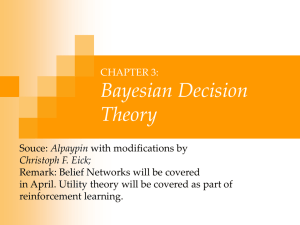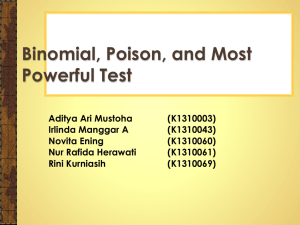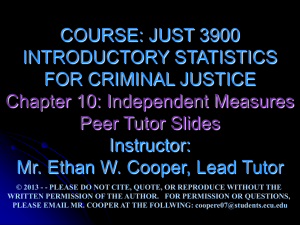Hypothesis Testing (Chapter 09)
advertisement
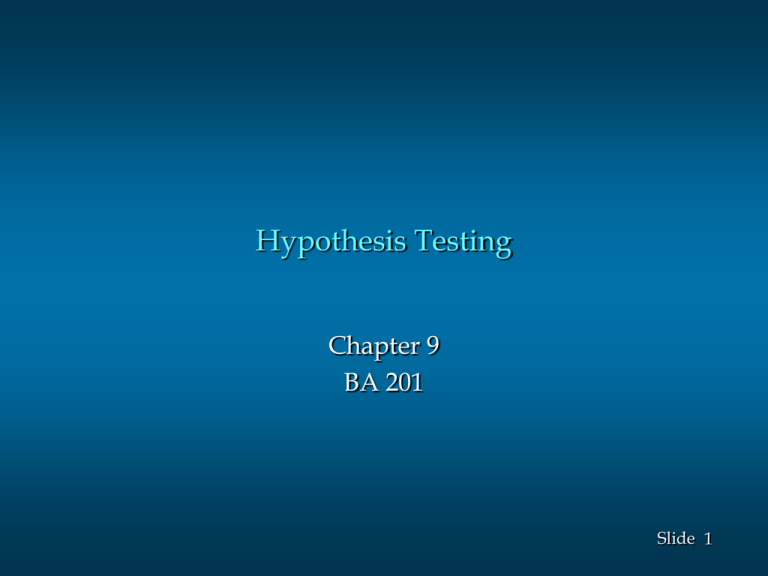
Hypothesis Testing Chapter 9 BA 201 Slide 1 Hypothesis Testing The null hypothesis, denoted by H0 , is a tentative assumption about a population parameter. The alternative hypothesis, denoted by Ha, is the opposite of what is stated in the null hypothesis. Slide 2 Summary of Forms for Null and Alternative Hypotheses about a Population Mean Three Scenarios: H 0 : 0 H a : 0 H 0 : 0 H a : 0 H 0 : 0 H a : 0 One-tailed (lower-tail) One-tailed (upper-tail) Two-tailed Slide 3 Type I and Type II Errors Population Condition Conclusion H0 True ( < 12) H0 False ( > 12) Accept H0 (Conclude < 12) Correct Decision Type II Error Type I Error Correct Decision Reject H0 (Conclude > 12) Slide 4 Two Scenarios Known z Score Unknown t Value Slide 5 HYPOTHESIS TESTING KNOWN Slide 6 p-Value Approach The p-value is the probability, computed using the test statistic, that measures the support (or lack of support) provided by the sample for the null hypothesis. Reject H0 if the p-value < . Slide 7 Tests About a Population Mean: Known Rejection Rule: p -Value Approach Reject H0 if p–value < Rejection Rule: Critical Value Approach H0: Ha: Reject H0 if z < -z H0: Ha: Reject H0 if z > z H0: Ha: Reject H0 if z < -z or z > z Slide 8 Lower-Tailed Test About a Population Mean = 0.10 p-value 7 z z = -z = -1.46 -1.28 0 Slide 9 Upper-Tailed Test About a Population Mean = 0.04 p-Value 11 z 0 z = 1.75 z= 2.29 Slide 10 Two-Tailed Tests About a Population Mean 1/2 p -value = .0031 1/2 p -value = .0031 /2 = /2 = .015 .015 z z = -2.74 -z/2 = -2.17 0 z/2 = 2.17 z = 2.74 Slide 11 z Statistics for Known x 0 z / n Where 0 is the mean under H0 is the population standard deviation n is the sample size Slide 12 One-Tailed Tests About a Population Mean: Known Metro EMS The response times for a random sample of 40 medical emergencies were tabulated. The sample mean is 13.25 minutes. The population standard deviation is believed to be 3.2 minutes. The EMS director wants to perform a hypothesis test, with a .05 level of significance, to determine whether the service goal of 12 minutes or less is being achieved. Slide 13 One-Tailed Tests About a Population Mean: Known p -Value and Critical Value Approaches 1. Develop the hypotheses. H0: 1 Ha: 1 2. Specify the level of significance. = 0.05 3. Compute the value of the test statistic. x 13.25 12 z 2.47 / n 3.2 / 40 Slide 14 One-Tailed Tests About a Population Mean: Known p –Value Approach 4. Compute the p –value. For z = 2.47, cumulative probability = 0.9932. p–value = 1 0.9932 = 0.0068 5. Determine whether to reject H0. Because p–value = 0.0068 < = .05, we reject H0. There is sufficient statistical evidence to infer that Metro EMS is not meeting the response goal of 12 minutes. Slide 15 One-Tailed Tests About a Population Mean: Known p –Value Approach Sampling distribution of z x 0 / n = .05 p-value z 0 z = 1.645 z= 2.47 Slide 16 One-Tailed Tests About a Population Mean: Known Critical Value Approach 4. Determine the critical value and rejection rule. For = 0.05, z0.05 = 1.645 Reject H0 if z > 1.645 5. Determine whether to reject H0. Because 2.47 > 1.645, we reject H0. There is sufficient statistical evidence to infer that Metro EMS is not meeting the response goal of 12 minutes. Slide 17 p-Value Approach to Two-Tailed Hypothesis Testing Compute the p-value using the following three steps: 1. Compute the value of the test statistic z. 2. If z is in the upper tail (z > 0), find the area under the standard normal curve to the right of z. If z is in the lower tail (z < 0), find the area under the standard normal curve to the left of z. 3. Double the tail area obtained in step 2 to obtain the p–value. Reject H0 if the p-value < . Slide 18 Two-Tailed Tests About a Population Mean: Known Glow Toothpaste The production line for Glow toothpaste is designed to fill tubes with a mean weight of 6 oz. Periodically, a sample of 30 tubes will be selected in order to check the filling process. Quality assurance procedures call for the continuation of the filling process if the sample results are consistent with the assumption that the mean filling weight for the population of toothpaste tubes is 6 oz.; otherwise the process will be adjusted. Slide 19 Two-Tailed Tests About a Population Mean: Known Glow Toothpaste Assume that a sample of 30 toothpaste tubes provides a sample mean of 6.1 oz. The population standard deviation is believed to be 0.2 oz. Perform a hypothesis test, at the 0.03 level of significance, to help determine whether the filling process should continue operating or be stopped and corrected. Slide 20 Two-Tailed Tests About a Population Mean: Known p –Value and Critical Value Approaches 1. Determine the hypotheses. H0: Ha: 6 2. Specify the level of significance. = .03 3. Compute the value of the test statistic. x 0 6.1 6 z 2.74 / n .2 / 30 Slide 21 Two-Tailed Tests About a Population Mean: Known p –Value Approach 4. Compute the p –value. For z = 2.74, cumulative probability = 0.9969 p–value = 2(1 0.9969) = 0.0062 5. Determine whether to reject H0. Because p–value = 0.0062 < = 0.03, we reject H0. There is sufficient statistical evidence to infer that the alternative hypothesis is true (i.e. the mean filling weight is not 6 ounces). Slide 22 Two-Tailed Tests About a Population Mean 1/2 p -value = .0031 1/2 p -value = .0031 /2 = /2 = .015 .015 z z = -2.74 -z/2 = -2.17 0 z/2 = 2.17 z = 2.74 Slide 23 Two-Tailed Tests About a Population Mean: Known Critical Value Approach 4. Determine the critical value and rejection rule. For /2 = .03/2 = .015, z.015 = 2.17 Reject H0 if z < -2.17 or z > 2.17 5. Determine whether to reject H0. Because 2.74 > 2.17, we reject H0. There is sufficient statistical evidence to infer that the alternative hypothesis is true (i.e. the mean filling weight is not 6 ounces). Slide 24 Two-Tailed Tests About a Population Mean: Known Critical Value Approach 1/2 p -value = .0031 1/2 p -value = .0031 Reject H0 z = -2.74 Reject H0 Do Not Reject H0 -2.17 0 2.17 z z = 2.74 Slide 25 PRACTICE KNOWN Slide 26 9.16 Slide 27 9.18 Slide 28 HYPOTHESIS TESTING UNKNOWN Slide 29 Tests About a Population Mean: Unknown x 0 t s/ n Where 0 is the mean under H0 s is the sample standard deviation n is the sample size This test statistic has a t distribution with n - 1 degrees of freedom. Slide 30 Tests About a Population Mean: Unknown Rejection Rule: p -Value Approach Reject H0 if p –value < Rejection Rule: Critical Value Approach H0: Ha: Reject H0 if t < -t H0: Ha: Reject H0 if t > t H0: Ha: Reject H0 if t < - t or t > t Slide 31 p -Values and the t Distribution The format of the t distribution table provided in most statistics textbooks does not have sufficient detail to determine the exact p-value for a hypothesis test. However, we can still use the t distribution table to identify a range for the p-value. An advantage of computer software packages is that the computer output will provide the p-value for the t distribution. Slide 32 Example: Highway Patrol One-Tailed Test About a Population Mean: Unknown A State Highway Patrol periodically samples vehicle speeds at various locations on a particular roadway. The sample of vehicle speeds is used to test the hypothesis H0: < 65. The locations where H0 is rejected are deemed the best locations for radar traps. At Location F, a sample of 64 vehicles shows a mean speed of 66.2 mph with a standard deviation of 4.2 mph. Use = .05 to test the hypothesis. Slide 33 One-Tailed Test About a Population Mean: Unknown p –Value and Critical Value Approaches 1. Determine the hypotheses. H0: < 65 Ha: > 65 2. Specify the level of significance. = .05 3. Compute the value of the test statistic. t x 0 66.2 65 2.286 s / n 4.2 / 64 Slide 34 One-Tailed Test About a Population Mean: Unknown p –Value Approach 4. Compute the p –value. For t = 2.286, the p–value must be less than .025 (for t = 1.998) and greater than .01 (for t = 2.387). .01 < p–value < .025 5. Determine whether to reject H0. Because p–value < = .05, we reject H0. We are at least 95% confident that the mean speed of vehicles at Location F is greater than 65 mph. Slide 35 One-Tailed Test About a Population Mean: Unknown Critical Value Approach 4. Determine the critical value and rejection rule. For = .05 and d.f. = 64 – 1 = 63, t.05 = 1.669 Reject H0 if t > 1.669 5. Determine whether to reject H0. Because 2.286 > 1.669, we reject H0. We are at least 95% confident that the mean speed of vehicles at Location F is greater than 65 mph. Location F is a good candidate for a radar trap. Slide 36 One-Tailed Test About a Population Mean: Unknown Reject H0 Do Not Reject H0 0 t = 1.669 t Slide 37 PRACTICE UNKNOWN Slide 38 9.28 Slide 39 9.30 (C.L. = 95%) Slide 40 Slide 41




